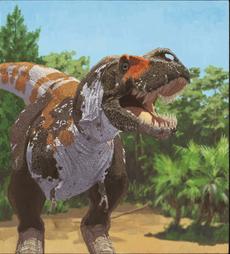Tyrannosaurus rex was still making a nice living, paleontologists report, but some other dinosaurs declined in numbers long before the asteroid hit 65.5 million years ago .
In the journal Nature Communications, a team led by Stephen Brusatte of the American Museum of Natural History in New York, look at seven major dinosaur sub-groups, ranging from T. Rex’s clan to vegetarian horned ceratopsids. In the study, the researchers estimate the ancient beast’s numbers from 77 to 65.5 million years ago, the late Campanian and Maastrichtian ages of the “Late Cretaceous” era that capped the Age of Dinosaurs.
“Despite 30 years of intensive research, a fundamental question remains: were dinosaurs undergoing a long-term decline before intensive volcanism and the Chicxulub bolide (asteroid) impact in the latest Cretaceous, or did these contingencies of Earth history strike down dinosaurs during or near their prime,” asks the study.
In past studies that focused on a few species, researchers have come to conflicting conclusions about whether or not dinosaurs (non-avian ones as opposed to the birds we still have with us) were already on the way out before the mass-extinction event — a.k.a. the Chicxulub bolide — that ended their reign. But looking across continents and multiple sub-groups (or clades),the team comes to a more nuanced view, via “rarefaction” analyses designed to assess species richness or diversity. They find:
“Some clades maintain consistent disparity across the late Campanian and Maastrichtian, most notably the carnivorous theropod dinosaurs (Coelurosauria, Tyrannosauroidea) and the small-to-medium-sized herbivorous pachycephalosaurs and ankylosaurs. One group, the enormous bulk-feeding sauropods (which did not have advanced chewing abilities), may have undergone a Campanian–Maastrichtian disparity increase, judging by the rarefaction results. On the other hand, the two clades of large- bodied, bulk-feeding herbivores with sophisticated jaw occlusion and dental batteries (Hadrosauroidea, Ceratopsidae) exhibit marked decreases.”
In other words, dinosaurs variously thrived or grew sparse across continents in varied ways, rather than displaying any overall pattern of increase or decline. Only the plant-eating Hadrosaur and Ceratops sub-groups were clearly declining.
“Even if the disparity of some dinosaur clades or regional faunas were in decline during the terminal Cretaceous, this does not automatically mean that dinosaurs were doomed to extinction,” concludes the study. After all, they note, “there are known instances in the fossil record in which major vertebrate clades endured catastrophic diversity and disparity losses, both during mass extinctions and normal background times, but later rebounded.”



 July 30th, 2012
July 30th, 2012  riffin
riffin 

 Posted in
Posted in 